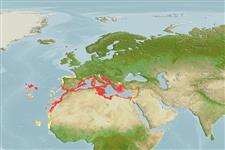Environment: milieu / climate zone / depth range / distribution range
Ecologia
marino demersale; distribuzione batimetrica 10 - 700 m (Ref. 4510). Subtropical; 15°C - 26°C (Ref. 130593); 45°N - 12°N, 32°W - 42°E
Eastern Atlantic: Bay of Biscay to Senegal, Madeira, Azores and the Canary Islands, including the Mediterranean (rare in northern Adriatic) and the Black Sea (as Scorpaena notata afimbria).
Size / Peso / Age
Maturity: Lm ? range ? - ? cm
Max length : 26.0 cm TL maschio/sesso non determinato; (Ref. 115876); common length : 12.0 cm TL maschio/sesso non determinato; (Ref. 3397); Età massima riportata: 8 anni (Ref. 91186)
Common in rocky littoral habitats. Feeds on crustaceans and small fishes (Ref. 4570). Flesh is tasty and used in making 'bouillabaisse' (Ref. 12382).
Hureau, J.-C. and N.I. Litvinenko, 1986. Scorpaenidae. p. 1211-1229. In P.J.P. Whitehead, M.-L. Bauchot, J.-C. Hureau, J. Nielsen and E. Tortonese (eds.) Fishes of the North-eastern Atlantic and the Mediterranean. UNESCO, Paris. Vol 3. (Ref. 4570)
IUCN Red List Status (Ref. 130435: Version 2024-2)
Human uses
Pesca: commerciale; Acquario: Commerciale
Strumenti
Special reports
Download XML
Fonti Internet
Estimates based on models
Preferred temperature (Ref.
123201): 13.2 - 16.2, mean 14.6 °C (based on 182 cells).
Phylogenetic diversity index (Ref.
82804): PD
50 = 0.5000 [Uniqueness, from 0.5 = low to 2.0 = high].
Bayesian length-weight: a=0.01288 (0.01139 - 0.01457), b=3.02 (2.99 - 3.05), in cm total length, based on LWR estimates for this species (Ref.
93245).
Trophic level (Ref.
69278): 3.7 ±0.2 se; based on diet studies.
Resilienza (Ref.
120179): Medio, tempo minimo di raddoppiamento della popolazione 1.4 - 4.4 anni (Preliminary K or Fecundity.).
Fishing Vulnerability (Ref.
59153): Low to moderate vulnerability (34 of 100).
Nutrients (Ref.
124155): Calcium = 107 [54, 272] mg/100g; Iron = 1.29 [0.67, 2.54] mg/100g; Protein = 18.6 [17.0, 20.0] %; Omega3 = 0.71 [0.32, 1.95] g/100g; Selenium = 39.4 [18.7, 89.7] μg/100g; VitaminA = 15 [5, 42] μg/100g; Zinc = 0.787 [0.541, 1.183] mg/100g (wet weight);
